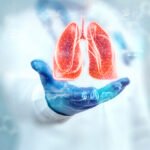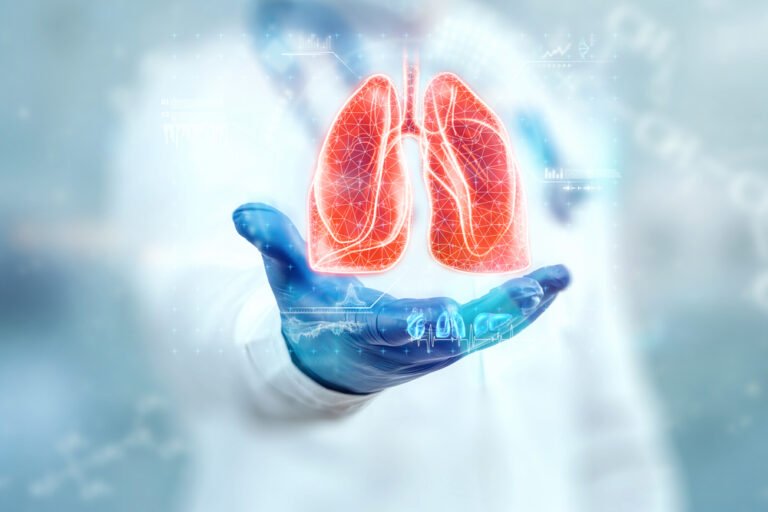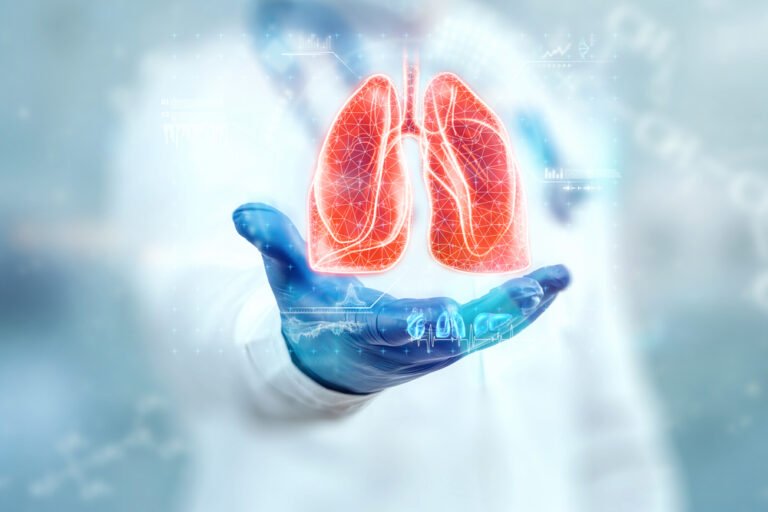COPD is characterized by airflow obstruction that is chronic, progressive and irreversible.
What is COPD?
COPD is characterized by airflow obstruction that is chronic, progressive and irreversible. It has two variants depending upon part of lung that is damaged.
- Chronic bronchitis (abnormality of airways)
- Emphysema (abnormality of alveoli)
(Alveoli are tiny sacs of air in lungs where exchange of gases take place during the process of breathing in and out)
Emphysema:
Emphysema is destruction of walls of alveoli leading to permanent enlargement of alveoli. This damage affects exchange of gases thus leading to the development of respiratory symptoms of COPD.
Chronic bronchitis:
It is defined as cough with sputum that is present for 3 months in each of 2 consecutive years with no other identifiable cause of sputum production. There is enlargement of mucus glands that are normally present in airways. Due to enlargement of these glands, there is excessive production of mucus that obstructs airways and creates resistance.
COPD can be genetic but is not contagious.
COPD classification on the basis of causes of COPD
-
COPD-G
COPD can be genetic . The best documented genetic risk factor for COPD is mutation in SERPINA-1 gene that leads to hereditary deficiency of Alpha-1 anti-trypsin (AATD). Few other gene mutations are also thought to be involved in causing COPD but there is no strong evidence for those genetic mutations. These include genes encoding matrix metalloproteinase 12 (MMP-12), Glutathione S- transferase, the alpha-nicotinic acetylcholine receptor, and hedgehog interacting protein (HHIP).
-
COPD-D
COPD due to abnormal lung development because of early life events (i.e. low birth weight, pre mature birth, maternal smoking during pregnancy, passive smoking exposure during infancy)
-
COPD-C
COPD due to
- Active cigarette smoking ( > 20 pack years )
- Second hand Cigarette smoking
- Vaping
- E-cigarette
- Cannabis
-
COPD-P
COPD due to exposure to
- Household pollution
- Air pollution
- Wildfire smoke
- Occupational hazards (organic and inorganic dust, fumes, pesticides and chemicals).
-
COPD-I
Severe infections like HIV, Tuberculosis and chronic pseudomonas can lead to development of COPD.
-
COPD-U
COPD due to unknown cause.
-
COPD-A
COPD and asthma. Asthma may also be a risk factor for the development of chronic airflow obstruction leading to COPD. There is 12-fold higher risk of developing COPD in asthmatics over time compared to those without asthma.
Diagnostic criteria:
Diagnosis of COPD should be considered in any patient who has shortness of breath, chronic cough or sputum production and history of exposure to risk factors along with irreversible airflow obstruction measured on spirometry (FEV1/FVC ratio < 0.7) post bronchodilation, that is mandatory.
What Are the Early signs of COPD?
Early signs of COPD include but not limited to the following:
-
Shortness of breath / Dyspnea
It is the most characteristic symptom of COPD. Shortness of breath gets worse with exercise, progresses over time and is persistent. Patients describe this symptom as a sense of increased effort to breathe, chest heaviness, air hunger, or gasping. Initially shortness of breath occurs only during physical activity or exertion.
-
Wheeze
-
Chronic cough
Chronic cough is often the first symptom of COPD and is frequently discounted by the patient as an expected consequence of smoking and /or environmental exposures. Initially cough may be intermittent but subsequently it may be present every day, often throughout the day. Cough may be with or without sputum. Patients might experience episodes of syncope (loss of consciousness) during prolonged attacks of coughing.
-
Sputum production
COPD patients commonly raise small quantities of tenacious sputum with coughing. Sputum production can be intermittent with periods of flare up interspersed with periods of remission. Large volume of sputum production reflects underlying bronchiectasis. Yellow sputum may indicate bacterial infection.
-
Fatigue
Tiredness or exhaustion is one of the most common and distressing symptom experienced by people with COPD. This fatigue is described as a feeling of general tiredness or as a feeling of being drained of energy. Fatigue affects patient ‘s ability to perform activities of daily living and quality of life.
-
History of risk factors
Risk factors are tobacco smoke, smoke from home cooking and heating fuels, occupational dusts vapors, fumes, gases and other chemicals. Developmental abnormalities, genetic factors, low birth weight, prematurity, childhood respiratory infections.
Additional clinical features in severe disease
Weight loss, muscle mass loss and anorexia are common problems in patients with severe COPD. These symptoms can be a sign of other diseases like tuberculosis or lung cancer in COPD patients. Ankle swelling may indicate involvement of heart in COPD. Depression and anxiety are also common.
What are the Stages of COPD?
There are 4 stages of COPD. Staging /grading of COPD is done on basis of FEV1 value that is obtained from spirometry.
MILD FEV1 > 80 %
MODERATE 50% < FEV1 < 80 %
SEVERE 30%< FEV1 < 50%
VERY SEVERE FEV1 < 30%
Modified MRC Dyspnea Scale
mMRC dyspnea scale grades dyspnea / shortness of breath on basis of patient’s severity of complaint. There are 4 grades/ stages of dyspnea / shortness of breath.
GRADE O I only get breathless with strenuous exercise.
GRADE 1 I get short of breath when hurrying on level or walking up a slight hill.
GRADE 2 I walk slower than people of the same age on the level because of breathlessness, or I have to stop for breath when walking on my own pace on the level.
GRADE 3 I stop for breath after walking about 100 meters or after a few minutes on the level.
GRADE 4 I am too breathless to leave the house or I am breathless when dressing or undressing.
Only one box should be selected to grade breathlessness.
Is asthma a form of COPD?
Asthma and COPD may show similarities in symptoms but are 2 different diseases. Both have different causes, pattern, course and treatment.
Some major differences of asthma and COPD are :
COPD
- Symptoms are persistent
- Slowly progressive
- Irreversible symptoms
- Smoking and other Risk factors present
- Two variants ( chronic bronchitis and emphysema)
- Later ages
- Spirometry shows irreversible obstruction
ASTHMA
- Variable airflow obstruction
- Symptoms vary widely from day to day
- Symptoms worse at night/ early morning
- Allergy, rhinitis, eczema, food allergy present
- Family history
- Early age
- Spirometry shows reversible obstruction
Is bronchiectasis COPD?
No. Let’s explain it a little more:
BRONCHIECTASIS
- Bronchiectasis is abnormal permanent dilatation of airways called bronchi.
- Causes are genetic, immune defect or infection
- Large volumes of sputum
- Bacterial infection is commonly present
- Chest Xray / CT scan shows airways dilatation and mucus plugs
- COPD can lead to development of bronchiectasis later through vicious cycle of airways inflammation and repeated infections.
COPD
- Smoking is the main cause along with other risk factors
- Small amount of tenacious sputum
- Bacterial infection less common and only during flare ups
- Chest xray / CT scan shows hyper inflated lungs
Does COPD cause heart failure?
COPD can lead to right sided heart failure that is also called Cor Pulmonale.
Chronic lung conditions like COPD leads to long standing low oxygen level in blood (i.e. hypoxia) and high carbon dioxide level in blood (i.e. hypercapnia). Both hypoxia and hypercapnia lead to pulmonary hypertension (i.e. raised pressure of vessels in lungs) which in turn lead to the development of right sided heart failure which in medical terms is called Cor-pulmonale.
Patients often present with their first episode of ankle swelling during a flare-up of their COPD. Cor -pulmonale is a marker of poor prognosis in COPD, with a five-year survival rate of ~50%. Long-term oxygen therapy is the main treatment in patients with cor-pulmonale and improves survival.
Signs of right heart failure/ cor-pulmonale
- Ankle swelling
- Breathlessness on lying flat on bed
- Visible neck vein ( JVP)
- Bluish discoloration of skin ( cyanosis)
Investigations for right heart failure
- Chest Xray (COPD changes i.e. hyperinflated lungs and prominent vessels of lungs)
- ECHO (it will show enlarged right side of heart, impaired heart valves on right side)
- Blood gases (low oxygen level i.e. below 8kPa and raised carbon dioxide level i.e. above 6kPa)
Management
- Long term oxygen at home ( LTOT)
- Di-uretics (medicines that increase urine output )
- Always elevate legs while sitting
- Salt restriction (<3 g/day) and fluid restriction (1.5 to 2 L/day)
COPD, a death sentence?
Yes, COPD can be a death sentence if its not controlled with regular daily medications, smoking abstinence and timely referral to emergency in case of flare ups.
COPD can lead to life threatening Respiratory Failure. It has following signs and symptoms:
- Respiratory rate >24 breaths per minute
- Use of accessory muscles of breathing
- Sudden change in mental status
- High level of carbon dioxide in blood (>60 mmHg)
- Acidosis (pH ≤7.25)
This is an emergency that needs to be addressed timely and quickly.
Investigations
- Blood gases (ABGs)
- Chest Xray
Management
- Bronchodilators
- Controlled oxygen
- No- invasive ventilation (BiPAP)
- Invasive ventilation (mechanical ventilator)
Prevention
How can one prevent flare up of COPD?
- Regular use of medications
- Proper follow ups with chest physician
- Careful use of oxygen therapy at home (only if advised by physician)
- Vaccinations (influenza, pneumococcal, COVID-19, RSV vaccine, zoster vaccine and dTaP vaccine)
- Pulmonary rehabilitation
- Abstinence from smoking









